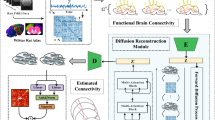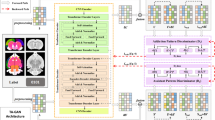Abstract
Functional Magnetic Resonance Imaging(fMRI) can reveal complex patterns of brain functional changes. The exploration of addiction-related brain connectivity can be more precise with fMRI data. However, it is still difficult to obtain addiction-related brain connectivity effectively from fMRI data due to the complexity and non-linear characteristics of brain connections. Therefore, this paper proposed a Graph Diffusion Reconstruction Network (GDRN), which could capture addiction-related brain connectivity from fMRI data of addicted rats. The diffusion reconstruction module effectively maintained the unity of data distribution by reconstructing the training samples. This module enhanced the ability to reconstruct nicotine addiction-related brain networks. Experiments on the nicotine addiction rat dataset show that the proposed model can effectively explore nicotine addiction-related brain connectivity.
Access this chapter
Tax calculation will be finalised at checkout
Purchases are for personal use only
Similar content being viewed by others
References
Hartmann-Boyce, J., Chepkin, S.C., Ye, W., et al.: Nicotine replacement therapy versus control for smoking cessation. Cochrane Database Syst. Rev. (5) (2018)
Beaglehole, R., Bates, C., Youdan, B., et al.: Nicotine without smoke: fighting the tobacco epidemic with harm reduction. Lancet 394(10200), 718–720 (2019)
Quach, B.C., Bray, M.J., Gaddis, N.C., et al.: Expanding the genetic architecture of nicotine dependence and its shared genetics with multiple traits. Nat. Commun. 11(1), 5562 (2020)
Heeger, D.J., Ress, D.: What does fMRI tell us about neuronal activity? Nat. Rev. Neurosci. 3(2), 142–151 (2002)
Allen, E.A., Damaraju, E., Plis, S.M., et al.: Tracking whole-brain connectivity dynamics in the resting state. Cereb. Cortex 24(3), 663–676 (2014)
Hu, S., Lei, B., Wang, S., et al.: Bidirectional mapping generative adversarial networks for brain MR to PET synthesis. IEEE Trans. Med. Imaging 41(1), 145–157 (2021)
Wang, S., Shen, Y., Zeng, D., et al.: Bone age assessment using convolutional neural networks. In: 2018 International Conference on Artificial Intelligence and Big Data (ICAIBD), pp. 175–178. IEEE (2018)
Wang, S.Q., Li, X., Cui, J.L., et al.: Prediction of myelopathic level in cervical spondylotic myelopathy using diffusion tensor imaging. J. Magn. Reson. Imaging 41(6), 1682–1688 (2015)
Hu, S., Yuan, J., Wang, S.: Cross-modality synthesis from MRI to PET using adversarial U-net with different normalization. In: 2019 International Conference on Medical Imaging Physics and Engineering (ICMIPE), pp. 1–5. IEEE (2019)
Shen, Y., Huang, X., Kwak, K.S., et al.: Subcarrier-pairing-based resource optimization for OFDM wireless powered relay transmissions with time switching scheme. IEEE Trans. Signal Process. 65(5), 1130–1145 (2016)
Lei, B., Liang, E., Yang, M., et al.: Predicting clinical scores for Alzheimer’s disease based on joint and deep learning. Exp. Syst. Appl. 187, 115966 (2022)
Hu, S., Yu, W., Chen, Z., et al.: Medical image reconstruction using generative adversarial network for Alzheimer disease assessment with class-imbalance problem. In: 2020 IEEE 6th International Conference on Computer and Communications (ICCC), pp. 1323–1327. IEEE (2020)
Wang, S., Hu, Y., Shen, Y., et al.: Classification of diffusion tensor metrics for the diagnosis of a myelopathic cord using machine learning. Int. J. Neural Syst. 28(02), 1750036 (2018)
Wang, S., Shen, Y., Chen, W., Xiao, T., Hu, J.: Automatic recognition of mild cognitive impairment from MRI images using expedited convolutional neural networks. In: Lintas, A., Rovetta, S., Verschure, P.F.M.J., Villa, A.E.P. (eds.) ICANN 2017. LNCS, vol. 10613, pp. 373–380. Springer, Cham (2017). https://doi.org/10.1007/978-3-319-68600-4_43
Zeng, D., Wang, S., Shen, Y., et al.: A GA-based feature selection and parameter optimization for support tucker machine. Procedia Comput. Sci. 111, 17–23 (2017)
Wang, S., Wang, H., Shen, Y., et al.: Automatic recognition of mild cognitive impairment and Alzheimer’s disease using ensemble based 3d densely connected convolutional networks. In: 2018 17th IEEE International Conference on Machine Learning and Applications (ICMLA), pp. 517–523. IEEE (2018)
Mo, L.F., Wang, S.Q.: A variational approach to nonlinear two-point boundary value problems. Nonlinear Anal. Theory Methods Appl. 71(12), e834–e838 (2009)
Wang, S., Wang, X., Shen, Y., et al.: An ensemble-based densely-connected deep learning system for assessment of skeletal maturity. IEEE Trans. Syst. Man Cybern.: Syst. 52(1), 426–437 (2020)
Yu, W., Lei, B., Wang, S., et al.: Morphological feature visualization of Alzheimer’s disease via multidirectional perception GAN. IEEE Trans. Neural Netw. Learn. Syst. (2022). https://doi.org/10.1109/TNNLS.2021.3118369
Lei, B., Yu, S., Zhao, X., et al.: Diagnosis of early Alzheimer’s disease based on dynamic high order networks. Brain Imaging Behav. 15, 276–287 (2021)
Yu, S., et al.: Multi-scale enhanced graph convolutional network for early mild cognitive impairment detection. In: Martel, A.L., et al. (eds.) MICCAI 2020. LNCS, vol. 12267, pp. 228–237. Springer, Cham (2020). https://doi.org/10.1007/978-3-030-59728-3_23
Hu, S., Shen, Y., Wang, S., Lei, B.: Brain MR to PET synthesis via bidirectional generative adversarial network. In: Martel, A.L., et al. (eds.) MICCAI 2020. LNCS, vol. 12262, pp. 698–707. Springer, Cham (2020). https://doi.org/10.1007/978-3-030-59713-9_67
Goodfellow, I., Pouget-Abadie, J., Mirza, M., et al.: Generative adversarial networks. Commun. ACM 63(11), 139–144 (2020)
Pan, S., Hu, R., Long, G., et al.: Adversarially regularized graph autoencoder for graph embedding. In: Proceedings of the 27th International Joint Conference on Artificial Intelligence, pp. 2609–2615 (2018)
You, S., Lei, B., Wang, S., et al.: Fine perceptive GANs for brain MR image super-resolution in wavelet domain. IEEE Trans. Neural Netw. Learn. Syst. (2022). https://doi.org/10.1109/TNNLS.2022.3153088
Yu, W., Lei, B., Ng, M.K., et al.: Tensorizing GAN with high-order pooling for Alzheimer’s disease assessment. IEEE Trans. Neural Netw. Learn. Syst. 33(9), 4945–4959 (2021)
Conte, G.M., Weston, A.D., Vogelsang, D.C., et al.: Generative adversarial networks to synthesize missing t1 and flair MRI sequences for use in a multisequence brain tumor segmentation model. Radiology 299(2), 313–323 (2021)
Pan, Y., Liu, M., Xia, Y., et al.: Disease-image-specific learning for diagnosis-oriented neuroimage synthesis with incomplete multi-modality data. IEEE Trans. Pattern Anal. Mach. Intell. 44(10), 6839–6853 (2021)
Zhou, B., et al.: Synthesizing multi-tracer PET images for Alzheimer’s disease patients using a 3d unified anatomy-aware cyclic adversarial network. In: de Bruijne, M., et al. (eds.) MICCAI 2021. LNCS, vol. 12906, pp. 34–43. Springer, Cham (2021). https://doi.org/10.1007/978-3-030-87231-1_4
Jiao, J., Namburete, A.I., Papageorghiou, A.T., et al.: Self-supervised ultrasound to MRI fetal brain image synthesis. IEEE Trans. Med. Imaging 39(12), 4413–4424 (2020)
Wolleb, J., Bieder, F., Sandkuhler, R.: Diffusion models for medical anomaly detection. In: Wang, L., Dou, Q., Fletcher, P.T., Speidel, S., Li, S. (eds.) MICCAI 2022. Lecture Notes in Computer Science, vol. 13438, pp. 35–45. Springer, Cham (2022). https://doi.org/10.1007/978-3-031-16452-1_4
Pinaya, W.H., Graham, M.S., Gray, R.: Fast unsupervised brain anomaly detection and segmentation with diffusion models. In: Wang, L., Dou, Q., Fletcher, P.T., Speidel, S., Li, S. (eds.) MICCAI 2022. Lecture Notes in Computer Science, vol. 13438, pp. 705–714. Springer, Cham (2022). https://doi.org/10.1007/978-3-031-16452-1_67
Khader, F., Mueller-Franzes, G., Arasteh, S.T., et al.: Medical diffusion - denoising diffusion probabilistic models for 3d medical image generation. arXiv preprint arXiv: Arxiv-2211.03364 (2022)
Chung, H., Ye, J.C.: Score-based diffusion models for accelerated MRI. Med. Image Anal. 80, 102479 (2022)
Mizutani, H., Yamamura, H., Muramatsu, M., et al.: Spontaneous and nicotine-induced Ca2+ oscillations mediated by Ca2+ influx in rat pinealocytes. Am. J. Physiol.-Cell Physiol. 306(11), C1008–C1016 (2014)
Keeley, R.J., Hsu, L.M., Brynildsen, J.K., et al.: Intrinsic differences in insular circuits moderate the negative association between nicotine dependence and cingulate-striatal connectivity strength. Neuropsychopharmacology 45(6), 1042–1049 (2020)
Claus, E.D., Blaine, S.K., Filbey, F.M., et al.: Association between nicotine dependence severity, BOLD response to smoking cues, and functional connectivity. Neuropsychopharmacology 38(12), 2363–2372 (2013)
Giessing, C., Thiel, C.M., Rosler, F., et al.: The modulatory effects of nicotine on parietal cortex activity in a cued target detection task depend on cue reliability. Neuroscience 137(3), 853–864 (2006)
Perry, E.K., Morris, C.M., Court, J.A., et al.: Alteration in nicotine binding sites in Parkinson’s disease, Lewy body dementia and Alzheimer’s disease: possible index of early neuropathology. Neuroscience 64(2), 385–395 (1995)
Pushparaj, A., Kim, A.S., Musiol, M., et al.: Involvement of the rostral agranular insular cortex in nicotine self-administration in rats. Behav. Brain Res. 290, 77–83 (2015)
Levin, E.D., Hall, B.J., Rezvani, A.H.: Heterogeneity across brain regions and neurotransmitter interactions with nicotinic effects on memory function. Neurobiol. Genet. Nicotine Tob., 87–101 (2015)
Nega, S., Marquez, P., Hamid, A., et al.: The role of pituitary adenylyl cyclase activating polypeptide in affective signs of nicotine withdrawal. J. Neurosci. Res. 98(8), 1549–1560 (2020)
Dehkordi, O., Rose, J.E., Millis, R.M., et al.: GABAergic neurons as putative neurochemical substrate mediating aversive effects of nicotine. J. Alcohol. Drug Depend. 6(2) (2018)
Saint-Mleux, B., Eggermann, E., Bisetti, A., et al.: Nicotinic enhancement of the noradrenergic inhibition of sleep-promoting neurons in the ventrolateral preoptic area. J. Neurosci. 24(1), 63–67 (2004)
Qi, X., Guzhva, L., Yang, Z., et al.: Overexpression of CRF in the BNST diminishes dysphoria but not anxiety-like behavior in nicotine withdrawing rats. Eur. Neuropsychopharmacol. 26(9), 1378–1389 (2016)
Acknowledgements
This work was supported by the National Natural Science Foundations of China under Grant 62172403, the Distinguished Young Scholars Fund of Guangdong under Grant 2021B1515020019, the Excellent Young Scholars of Shenzhen under Grant RCYX20200714114641211 and Shenzhen Key Basic Research Project under Grant JCYJ20200109115641762.
Author information
Authors and Affiliations
Corresponding author
Editor information
Editors and Affiliations
Rights and permissions
Copyright information
© 2023 The Author(s), under exclusive license to Springer Nature Switzerland AG
About this paper
Cite this paper
Jing, C., Gong, C., Chen, Z., Wang, S. (2023). Graph Diffusion Reconstruction Network for Addictive Brain-Networks Identification. In: Liu, F., Zhang, Y., Kuai, H., Stephen, E.P., Wang, H. (eds) Brain Informatics. BI 2023. Lecture Notes in Computer Science(), vol 13974. Springer, Cham. https://doi.org/10.1007/978-3-031-43075-6_12
Download citation
DOI: https://doi.org/10.1007/978-3-031-43075-6_12
Published:
Publisher Name: Springer, Cham
Print ISBN: 978-3-031-43074-9
Online ISBN: 978-3-031-43075-6
eBook Packages: Computer ScienceComputer Science (R0)




